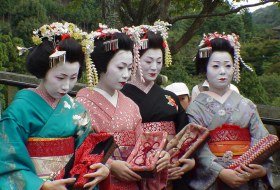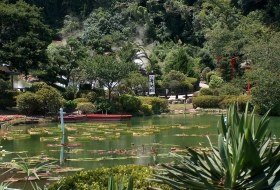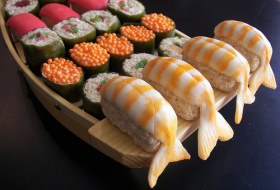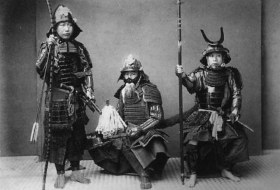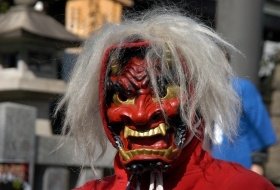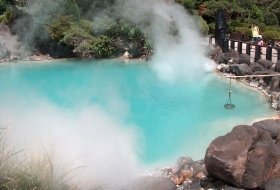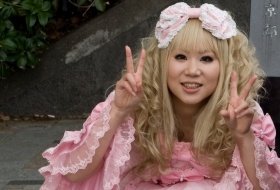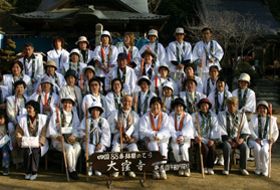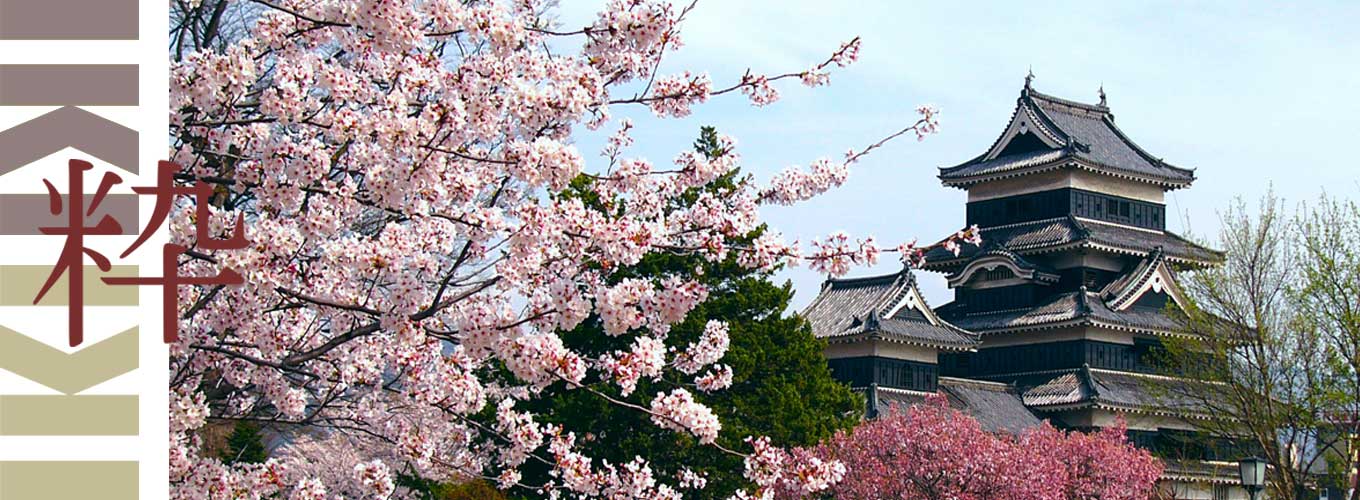
iki, something typically Japanese
The Japanese word “iki” 粋 originated in the Tokugawa period in Edo, late 17th century. The word was used by the emerging middle class of merchants, artisans and geishas. “iki” stands for a traditional aesthetic ideal in Japan.
If you ask a Japanese person about the meaning of the word “iki”, he or she will usually not know how to answer this question. It is impossible to explain, but every Japanese knows exactly what it means.
The words that best describe the word “iki” are words like chic, courageous, spontaneous, original and elegant. The word “iki” can definitely not be described as pretentious, complicated, showy, cute or arrogant.
Geisha yes, samurai no
Iki is a traditional aesthetic ideal in Japan. We could say that someone, something or a situation is iki, when it is authentic, refined and chic without being perfect or complicated. It is distinct from more ethereal notions of transcendence or poverty. In Japan, geisha are iki; they are beautiful, sophisticated and stylish, but they don’t have the intention to be perfect. Iki also applies to Japanese gardens, tempels and architecture. As such, samurai, for example, would typically, as a class, be considered devoid of iki. At the same time, individual warriors are often depicted in contemporary popular imagination as embodying the iki ideals of a clear, stylish manner and blunt, unwavering directness.
Yabo is the antonym of iki. Busui, literally “non-iki,” is synonymous to yabo. Something that is yabo is usually unrefined, gigantic, coarse, childish, colourful, self-conscious, permanent, loud, superficial, vulgar, snobbish, boorish, etc. In Japan, the word yabo was often used by city dwellers, or Chōnin (especially those of Edo). It often refers to samurai and farmers from outside Edo. “Salarymen” are generally considered “yabo”.
ikigai
ikigai
Ikigai is a Japanese term for a “reason for being.” The word ‘ikigai’ usually refers to the source of value in one’s life or the things that make one’s life worthwhile. Each individual’s ikigai is personal to them and specific to their lives, values and beliefs.
The term ikigai compounds two Japanese words: iki, meaning “life; alive” and kai, meaning “(an) effect; (a) result;(a) benefit”, etc., to arrive at “a reason for living; what makes life worth living; a raison d’être”.
In his article the Japanese psychiatrist Kobayashi Tsukasa articulates that “people can feel real ikigai only when, on the basis of personal maturity, the satisfaction of various desires, love and happiness, encounters with others, and a sense of the value of life, they proceed toward self-realisation”. In addition to that, there is also a mental and spiritual connotation.One must not sit idle, even in the face of adversity. Even if the present seems dark and the future uncertain, as long as one is in active pursuit of a goal, through meditation or some other spiritually and mentally beneficial activity, then they may still reach ikigai.
Japan country of manga, anime, cosplay and kawaii
What is manga and anime?
The words “manga” and “anime” refer to a specific Japanese way of drawing. The word manga in Japan is a word used to refer to both comics and cartooning. The word anime is the Japanese term for animation, which means all forms of animated media. Large eyes and facial expressions can communicate emotions very quickly. Manga is traditionally in black and white, but sometimes the characters come in colour (characters with pink, green or blue hair are quite common). Both manga as well as anime come in endless varieties and both are becoming increasingly popular worldwide. In The Netherlands and Belgium, you can buy translated manga (which still has to be read from right to left). Besides the famous anime series Pokémon and Dragonball Z, many Japanese cartoons can nowadays be watched on television or via internet, where manga is mostly translated to English.
Lots of anime are spoken in Dutch or dubbed in English with subtitles. The real fans watch the series in Japanese with English subtitles. Typically, a small group of people scan the original version of a series with no current license in the language which they wish to translate it to, translate it, and freely distribute it.
Cosplay
Otaku is a Japanese term for people with obsessive interests, particularly in anime and manga. In the West otaku is used by fans to underline the fact that they are big fans; in Japan the term has become less negative, and an increasing number of people now self-identify as otaku, both in Japan and elsewhere.
A good example of the more serious fans are the cosplayers. Cosplay is a word that has its root in costume play. It is both a noun and a verb.Cosplay can mean the actual costume, as well as the action of wearing it. Cosplay means dressing up and pretending to be a fictional character (usually a sci-fi, comic book, or anime) These costumes are often sold online, but also can be purchased in boutiques. Other cosplayers prefer to create their own costumes. It is also more common for Western cosplayers to recreate characters from Western media. To outsiders cosplayer just look like normal teenagers, who dress up in weird, eccentric clothes. The Harajuku area in Tokyo is renowned for its many “Japanese street fashion” boutiques, where teenagers gather, shop and socialise. Anime conventions have become more numerous in the West and cosplayers regularly show up at special events related to manga, anime and videogames.
Kawaii culture
In Japan many adults read manga or watch anime and yes otaku (obsessive fans) are considered weird.In recent years Japan has been obsessed about mascots! Each and every city, sports club, company, shop, or even police corps has a cute figure as a mascot. They are usually created to promote a place or region, event, organisation or business. They are characterised by their kawaii. In English, kawaii means cute, pretty, lovely, or charming. Kawaii can be used to refer to an object, an action, a fashion choice, facial expression, or even “a way of being,” that is just, overall, endearing. Being cute doesn’t mean that you should not be taken seriously. It’s just a total different cultural custom that is totally normal in Japan. Cute mascots make companies more accessible; it gives them a face and personality.
Cuteness in Japan is a positive characteristic; it is seen everywhere, also in young women (who rather appear to be cute than sexy), in mascots and of course in manga and anime.
Iki travels designed a few sample theme tours with a focus on manga, anime and cosplay. It is common allover Japan, but especially in Tokyo and Osaka
Japan and festivals
Japan and festivals
There are countless local festivals (matsuri) in Japan. Almost every shrine celebrates one of its own. Most festivals are held annually and celebrate the shrine’s deity or a seasonal or historical event. Some festivals are held over several days. It’s very plausible that while wandering around you suddenly bump into a festival parade.When you get the chance to attend such a local festival, just go for it. Even though they are crowded, there is no better way to experience Japanse culture, history, pride and traditions as by attending such religious or cultural festivals. Every festival has its own characteristics. While some festivals are calm and meditative, many are energetic and noisy. Cultural traditions and religion are interwoven.
Of course it is impossible to go through each and every Japanese festival, but when we send you a price quotation, we will check whether there is a special event happening during your itinerary.
To give you an idea, hereby some of the more famous festivals van Japan.
Takayama Matsuri
The Takayama Festival is held twice a year, in spring and in fall, in Takayama. It is ranked as one of Japan’s three most beautiful festivals alongside Kyoto’s Gion Matsuri and the Chichibu Yomatsuri. With its fancy parade floats and traditional clothing, this festival is extremely captivating. Every neighbourhood or company has its own float decorated with colourful paper lanterns. During the year, the tall and heavily decorated floats are stored in storehouses, which are scattered across Takayama’s old town. Some of the floats are exhibited in the Yatai Kaikan which is open to the public.
Gion Matsuri in Kyoto
Gion Matsuri is the most famous festival in Japan. It takes place during the entire month of July. The highlight is the grand procession of floats called “Yamaboko Junko” on the 17th of July. One of the main reasons the Gion Matsuri is so impressive is the enormity of the bamboo hoko (float). Both yama and hoko are elaborately decorated with lanterns etc and represent unique themes.The area becomes most exciting in the evenings, when the streets are closed to traffic and the area swells with food stands, drink vendors and other festival hallmarks. Ladies dress up in traditional yukata (an easy kimono for the summer) with colourful umbrellas. Just picture yourself wandering the charming streets of Kyoto on a warm summer evening. You probably never wanna go home again!
Jidai matsuri in Kyoto
The Jidai Matsuri is a traditional Japanese festival held annually on October 22 in Kyoto. It is one of Kyoto’s renowned three great festivals, with the other two being the Aoi Matsuri, held annually on May 15, and the Gion Matsuri, which is held annually from 17 to July 24. The Jidai Matsuri begins in early morning with the mikoshi (portable shrines) brought out of the Kyoto Imperial Palace so that people may pay their respects. The five-hour, two-kilometer costume procession begins in the afternoon with approximately 2000 performers dressed as samurai, military figures, and common people. People of all ages participate in its historical reenactment parade and dress up in authentic costumes representing various periods, and characters in Japanese feudal history.
Tenjin Matsuri in Osaka
The Tenjin Festival of Osaka is also ranked a one of Japan’s top three festivals. After the procession arrives at Okawa River, its members and portable shrines are loaded onto boats to be paraded up and down the river. The fireworks of the Tenjin Matsuri, combined with the illuminated boats and their reflections off the river, make for a truly unique spectacle.
Sanno Matsuri – Tokyo
This festival takes place in mid June in even numbered years, alternating with the Kanda Matsuri which takes place in odd numbered years. The Sanno Festival extends over a week and has a few events, but most of them are rather small.The festival’s main attraction is a parade that winds through Tokyo. The procession consists of only some modest sized floats and about 500 people, who are dressed in colourful costumes. The parade begins and ends at Hie Shrine, (the shrine responsible for holding the festival), passing by and by the Yasukuni shrine and Tokyo’s imperial palace.During the festival, vistors can enjoy the authentic Shinto music, tea ceremonies, flower arrangements and much more.
Kanda Matsuri – Tokyo
Kanda Matsuri is one of Tokyo’s three main festivals and is a festival for the Kanda Myojin Shrine.The main action happens during the middle of May in odd numbered years, alternating with the Sanno Matsuri which is held in even numbered years.The Kanda Festival consists of numerous events held over an entire week, but the main action usually happens over the weekend closest to May 15.The highlights are a day-long procession through central Tokyo on Saturday, and parades of portable shrines (mikoshi) by the various neighbourhoods on Sunday.
Tohoku
In the month of August, Tohoku is worth a visit. This area north of Tokyo is more rural and cooler than Kyoto. It is well known for its countryside, mountains, lakes, hot springs, high quality rice and rough winters. You won’t see many other foreigners here as it is off the standard tourist trail. In summer there are many colourful festivals.
Book on time !
During festival times things get very busy. If you would like to attend one of the Japanese festivals, you need to book well in advance to make sure rooms are available.
Iki Travels, your Japan travel expert, will take care of all your hotel bookings during traditional festivals in the Land of the Rising Sun.
Iki travels designed many Japan Sample Itineraries. Depending on your travel dates, you can easily include a festival in your tour.
Taking a break from the city jungle
Forests, mountains and volcanoes
Japan has some amazing natural scenery, but you have to make an effort to go and search for it, while the nice and super fast Shinkansen will only whisk you from big metropolis to another. Hokkaido Island has the largest reserves of untouched nature in all of Japan, far away from the hustle and bustle of the modern world. However, it is a remote and isolated area. When your travel time is limited, it’s may be better to save it for your next visit to Japan. In this case, you can visit the Japanese Alps, also known as “the roof of Japan”, and not too far from Tokyo. Apart from the Japanese towns and villages, this area resembles the European Alps; there are many ski resorts and the majestic mountains offer nice hiking opportunities. In 1998 the Winter Olympics were held in Nagano.
Kyushu Island has a unique, rugged and barren landscape as well, resembling a lunar landscape. In Mount Aso, you can visit the world’s largest caldera and the east shore of Kyushu is known for its superb rugged coastline.
When you want to see what Japan’s underwater world has to offer, take a flight to Okinawa, the perfect place dive and snorkel or to just relax and unwind. Famous for its coral reefs, rich marine life, turquoise waters, and tropical climate, Okinawa attracts many tourists from around the world.
There is no need to travel to the farthest corners of Japan to see some unique nature. The Bamboo Grove is one of Kyoto’s top sights and for good reason: standing amid these soaring stalks of bamboo is like being in another world. Not far from the super crowded Kyoto the small village located in romantic rural valley are definitely worth visiting.
Mount Fuji and hot springs
And what about Mount Fuji? This mesmerising mountain can be visited on a day trip from Tokyo. In case you want to climb Mount Fuji, you will have to spend minimum one night.You can only climb up in July and August, when it’s also very busy on the mountain. Get up in the middle of the night and climb to the top in a couple of hours, just in time to reach the summit and enjoy sunrise.
In Japan, ultra modern city life can go hand in hand with unspoiled nature and a traditional unspoiled way of life, which can still be found in the countryside. What could be more relaxing than lowering yourself in a soothing hot spring, (onsen) after a long day of hiking? Onsens can be found allover Japan. A bath in a hot spring is perfect way to unwind and relax and take time for yourself.
Iki Travels can also organise an active holiday, whether you want to go skydiving, rock climbing or do some serious mountain hiking. Everything is possible.
Onsen
An onsen is a Japanese hot spring. Onsens by definition use naturally hot water from geothermally heated springs. The term also extends to cover the bathing facilities and traditional inns frequently situated around a hot spring. As a volcanically active country, Japan has thousands of onsens scattered throughout all of its major islands.
Depending on the amount of minerals present in the water, the colour of the hot spring may vary; some springs have very interesting colours. Japanese believe that certain hot spring also have medicinal properties. The most famous onsens, such as in Beppu, are surrounded by beautiful Japanese gardens.
Bathing together
The Japanese love soaking in the tub. While in the West, a bath (or a shower) is just a quick personal hygiene routine, taking a bath in Japan takes time. It is a ritual, a tradition that contributes to a sense of belonging to a culturally united group of people. Bathing in Japan is called ofuro. Ofuro and onsens are generally very hygienic because of the bathing etiquette. At an onsen, all guests are expected to wash and rinse themselves thoroughly before entering the hot water. Bathing stations are equipped with stools, faucets, wooden buckets and toiletries such as soap and shampoo. Nowadays, many people rinse with a shower head instead. Entering the onsen while still dirty or with traces of soap on the body is socially unacceptable. A towel can provide a modicum of modesty when walking between the washing area and the baths
Traditionally, men and women bathed together, but gender separation has been enforced since the opening of Japan to the West. To keep their towels dry during bathing, they place their folded towels on top of their heads.
Relaxing in a spa
High-end ryokans and Westerns hotels often have nice spa facilities with inside and outside pools. Luxury ryokans often take great pride in their beautiful bathing facilities and spas and even have private hot spring baths in their guest rooms. Ryokans with fantastic Mount Fuji views from spots such as the private open-air hot spring baths and the guest rooms are definitely not cheap; prices easily go up to a few hundred euros per person per night.While this may be too expensive to stay at everyday, it is well worth indulging on one special night during your travels.
Some luxury ryokan open their baths to non-staying guest during the day for an entrance fee.
Who came first, monkeys or people?
In this case, people came first. Bathing in an onsen is a century old tradition.The wild macaque monkeys started mimicking the behaviour of people sitting in the water. They decided the hot spring felt nice and didn’t want to move from there. Of course, the hygiene-obsessed Japanese didn’t like to share their hot spring with monkeys and got chased away. Nowadays, there are monkey-only pools and walled hot springs for people. The bathing monkeys is now a world-famous sight.
Tattoos
Public pools, gyms, resorts. It’s very common to see “no tattoos allowed” signs at establishments like this. In Japan, there is certainly a stigma towards tattoos. The easiest explanation is that Japanese gangsters (the yakuza) traditionally mark their bodies with tattoos. It wasn’t until after World War II that the legal prohibition against tattooing was lifted. If you have tattoos and visiting Japan, you might run into problems at, for example, hot springs. Better to rent a room at hot springs that come with a private bath.
Japan, the land of the Samurai
Samurai in charge
The samurai were the warriors of premodern Japan. Everybody is familiar with a samurai in full armour. Samurai employed a range of weapons such as bows and arrows, spears and guns, but their main weapon and symbol was the sword.Their sense of loyalty, will power, courage and self sacrifice speaks to everyone’s imagination and their heroic tales filled the pages of history and have been a favourite theme in movies. The first duty of a samurai was absolute loyalty to his lord, often carried to extremes.Samurai would fight to the death in a hopeless battle to protect their master’s castle, or commit suicide if they felt they had disgraced their lord. Until the 17th century Japan was plagued by many civil wars and clan disputes. Consequently, warriors were in high demand and frequently hired by the emperor or wealthy landowners.
The samurai would gain more and more power and eventually challenged the central government. The samurai clans emerged victorious and set up a new military government, led by the shogun (the supreme military commander). The samurai would rule over Japan for most of the next 700 years. Four noble samurai clans became the rulers of Japan. The samurai lived in castle towns, and were the only ones allowed to carry swords and were paid in rice by their daimyo or feudal lords.
With no warfare since the early 17th century, samurai gradually lost their military function. This period of relative peace prevailed is called the Edo Period. Samurai still had certain special privileges and were allowed to kill citizens if they did not behave properly.
The decline of the samurai came in the late nineteenth century as Japan opened its borders to the US navy and the power was given back to the imperial family in the Meiji Restoration in 1868. Samurai became known as shizoku, a term which represented their former samurai status, and they were no longer allowed to wear a katana in public.
Visiting a Samurai
Samurai related attractions can be found across Japan in form of castles, historic residences, museums, etc. Most of the castles contain exhibits or entire museums that display samurai artefacts and lifestyle. The gardens surrounding these castles are often more interesting than the castle itself. In other cases, single samurai mansions have been preserved and opened to the public. Famous samurai castles are Matsumoto Jo, Kumamoto Jo and the White Heron castle in Himeji.
Today, a few of the samurai districts remain preserved with their historic atmosphere of narrow lanes, earthen walls, entrance gates and residences, and allow tourists to get a glimpse into the samurai lifestyle, e.g. the Samurai district in Kanazawa.You will see that ancient Japanese epics all come alive.
47 Ronin
One of the most famous stories in Japan is Forty-seven Ronin. It’s an 18th-century historical event in Japan in which a band of rōnin (leaderless samurai) avenged the death of their master. The incident has since become legendary.
The story tells of a group of samurai who were left leaderless (becoming rōnin) after their feudal lord was compelled to perform seppuku (ritual suicide) for assaulting a court official called Lord Kira. The 47 rōnin pretended to live a loose life as bad samurai and all the time drunk, just to mislead the court official. Fearing a plot growing against him, a cautious Lord Kira sent spies to watch the Ronin. After waiting and planning for 2 years, the rōnin avenged their master’s honour by killing Kira. Once Kira was dead, they cut off his head and lay it as an offering on their master’s tomb. As expected, the rōnin were sentenced to death for the murder of Kira; but the shōgun finally resolved the quandary by ordering them to honourably commit seppuku instead of having them executed as criminals. Seppuku was used either voluntarily by samurai to die with honour rather than fall into the hands of their enemies or as a form of capital punishment for samurai who had committed serious offences, or performed because they had brought shame to themselves.
This true story was popularised in Japanese culture as emblematic of the loyalty, sacrifice, persistence, and honour that people should preserve in their daily lives.
The tombs of the 47 ronin and their master at Sengakuji tempel in Tokyo, became a place of great veneration and people flock there to pray.
Japanse martial arts
Budo
Budō is a Japanese term describing modern Japanese martial arts. Literally translated it means the “Martial Way,” its historical origin can be found in the warrior traditions of the samurai and the caste system that restricted the use of weapons by other members of society. The various types of martial arts are judo, karate, aikido, sumo and kendo.
Budō is a compound of the root bu, meaning “war” or “martial”; and dō, meaning “path” or “way”. Budō is the idea of formulating propositions, subjecting them to philosophical critique and then following a “path” to realise them. Dō signifies a “way of life”. The usage of term budō to mean martial arts is a modern one. Historically the term meant a ‘way of life’, encompassing physical, spiritual and moral dimensions with a focus of self-improvement, fulfilment or personal growth.
Japanese martial arts may generally be divided into koryū (such as ninjutsu and jujutsu) and gendai budō (such as judo and aikido) based on whether they existed prior to or after the Meiji Restoration.
Martial arts etiquette and procedures
One of the curious aspects of studying a Japanese martial art outside of Japan is the retention and use of cultural and social aspects of Japanese tradition, including the use of Japanese terminology for techniques, methods and concepts.
In fact, historically, the samurai had to follow a code of conduct called bushido. Those warriors always had to abide to the Eight virtues of Bushido: righteousness, courage, benevolence, respect, honesty, honour, and loyalty and self-control.
These virtues can still be found today in Japanese martial arts. Take a sumo fight for instance. Before a fight, opponents bow to each other as a sign of respect. From the way a fighter is holding his sword, you can tell whether or not he wants to fight. An aikido practitioner holds his bokken (wooden sword) on the right (unarmed) side. After bowing in with the weapon, it is transferred to the left (or armed side) and is placed next to you on the left with the blade facing away when you are seated. After training ends and you bow out, the bokken is returned to the right side.
Historically, the ranking system was used by many Japanese organisations to indicate the level of one’s ability within a certain subject matter. This system was also applied to martial arts. Holders of dan ranks often wear a black belt; those of higher rank may also wear red-and-white and red belts. Sometimes you can tell someone’s rank, just by looking at the way he sits or stands on the mat.
Weapons
Most budo make use of weapons, made out of wood or steel. Historically, katana were one of the traditionally made Japanese swords that were used by the samurai of ancient and feudal Japan. The katana is characterised by its distinctive appearance: a curved, single-edged blade with a circular or squared guard and long grip to accommodate two hands, in short: big, long sword. The wakizashi (short sword) is being worn together with the katana as well as a tanto (knife). It was the official sign that the wearer was a samurai or swordsman.
Traditionally forging a katana was a way to attain perfection and a blade smithing was surrounded by religious purification rituals. Katanas are traditionally made from a specialised Japanese steel called tamahagane, which is only manufactured once a year. The best sword smiths begin by folding and welding pieces of the steel several times to work out most of the differences in the steel. Basically, two different types of steel are beaten together. The result is a strong sword that is known worldwide for its sharpness. To own a katana in Japan is a special thing and it is a very valuable object as well.
Some budo make use of authentic katana, but usually they replace them by high quality wooden weapons ,such as bokken (wooden sword), a wooden tanto, and a jo (wooden stick). Kyodo (the way of the bow) makes use of an authentic Japanese bow and arrow.
Japanse Buddhism, just slightly different
History of Japanese Buddhism
Buddhism was imported to Japan via China and Korea in the 6th century via the port town Fukuoka in southern Kyushu. Fukuoka and later Nagasaki were for a long time the only entrance gates for foreigners to Japan. Therefore, on Kyushu Island you will come across more foreign influences.
During the 7th through 9th centuries, Buddhism in China enjoyed a “golden age” and Chinese monks brought the newest developments in practice and scholarship to Japan. Many schools of Buddhism emerged. Buddhism officially became the main religion in Japan. Because of Japan’s long period of isolation, Buddhism developed its own unique character. Buddhism and Zen are closely interrelated.
Visiting tempels
Japan has 80.000 temples and seeing all of them is of course impossible. A carefully designed travel itinerary makes sure you won’t experience temple fatigue. Japan’s most beautiful temples and shrines can be found in and around Kyoto. From Kyoto it’s an easy day trip to Nara, where you can visit the Todai-ji temple and from Tokyo you can make a day trip to Nikko or Kamakura.To stay overnight in a Japanese temple is really a unique experience. Iki Travels can arrange this. You will spend the night at the temple, participate in morning prayers, join the monks for breakfast and dinner and why not attend a tea ceremony as well?
The 88 tempel pilgrimage
In de 9de eeuw liep de oprichter van het Shingon Zen-Boeddhisme, de Zen meester Daishi langs 88 tempels op zoek naar verlichting. Sindsdien lopen er vele volgelingen deze route, die gelegen is op het eiland Shikoku. U kunt de pelgrims herkennen aan hun witte kleding, hun wandelstok en hun bamboepunthoed. Natuurlijk kunt u een deel van deze route meelopen of smokkelen door één van de vele busjes tussen de tempels te nemen. Ook hier hebben de japanners de eeuwen oude tradities weten te combineren met de moderne middelen.
The 88 temple pilgrimage traces the route that a monk named Kukai, walked in his youth during a period of asceticism and search for truth. Kukai (born in 774) is credited founding the Shingon sect of Japanese Buddhism. The 88 Temple pilgrimage is approximately 1600 km long and circumambulates the island of Shikoku. Most pilgrims walk the route in a clockwise direction which can take up to 2 months to complete. Pilgrims can easily be recognised by three particular items: a traditional white jacket, a wooden staff and a conical sedge. It is also not necessary to do the whole pilgrimage in one go, many people do so in sections. In earlier days there was only one method of travel for the pilgrimage: walking. Nowadays, you can visit the temples by public transport or by tour bus. A combination of walking and public transport is also perfectly feasible. As usual, the Japanese manage to combine century old traditions with modern means.
Japanse forms of arts
Japanese Calligraphy – Shodou – 書道
Shodou means the “Way of writing”. For Japanse calligraphy perseverance, endurance, strength and patience are required. Shodou is closely related to Zen Buddhism, the movement of the brush needs a lot of concentration and coordination. This is what we call ‘mushin’ a state of mind in which you live your mind in blank. Finally, the result of the work is balance and harmony in writing.
In calligraphy there are actually very many styles of writing (and many different kind of paper), but we’ll be focusing on the three main ones. The first style a beginner learns when starting to practise the art of calligraphy is kaisho (the “formal,” or “square” type). Gyosho is the more cursive script, roughly approximating normal, everyday handwriting. It is often referred to as the semi-cursive script. Sosho is the most cursive script of them all, and it is frequently impossible to read characters written in sosho style without having nearly mastered the style yourself.
Ukiyo-e
Literally meaning “Pictures of the Floating World,” Ukiyo-e refers to a style of Japanese woodblock print and painting from the Edo period depicting famous theater actors, beautiful courtesans, city life, travel in romantic landscapes, and erotic scenes.The style is a mixture of the realistic narrative of the emaki (“picture scrolls”) produced in the Kamakura period and the mature decorative style of the Momoyama and Tokugawa periods. The ukiyo-e style also has about it something of both native and foreign realism. The genre flourished from the 17th through 19th centuries, when artists produced woodblock prints and paintings of such subjects as female beauties; kabuki actors and sumo wrestlers; scenes from history and folk tales; travel scenes and landscapes; flora and fauna; and erotica.
Ukiyo-e has many different styles and formats: Beni-e, Beni-girai, Ichizuri-e, Sumi-e, Sumizuri-e, Surimono, Tan-e.
| Beni-girai |
Consciously use quieter color combinations |
| Benizuri-e |
“crimson picture” primitive ukiyo-e style prints usually printed in pink and green |
| Ichizuri-e |
a print that mimics a stone rubbing, with uninked images or text on a dark, usually black, background |
| Sumi-e |
Black § white prints |
| Sumizuri-e |
a print done in black and white (no shades of grey) |
| Surimono |
Very detailed prints, privately commissioned for special occasions |
| Tan-e |
hand-coloured prints with an orange-red tone. |
Thee ceremony – Chadou – 茶道
Chadou (茶 ちゃ) en (道 どう)The Japanese tea ceremony, also called the Way of Tea, is a Japanese cultural activity involving the ceremonial preparation and presentation of matcha, powdered green tea. In Japanese it is called Chadou, the “way of tea” or the “art of tea”.Tea gatherings are classified as an informal tea gathering chakai and a formal tea gathering chaji. A chakai is a relatively simple course of hospitality that includes confections, thin tea, and perhaps a light meal. A chaji is a much more formal gathering, usually including a full-course meal followed by confections, thick tea, and thin tea. A chaji can last up to four hours.
Kintsugi
Kintsugi is the Japanese art of repairing broken pottery with lacquer dusted or mixed with powdered gold, silver, or platinum.
Ikebana
Ikebana is the Japanese art of flower arrangement. Ikebana is counted as one of the three classical Japanese arts of refinement, along with kōdō for incense appreciation and chadō for tea and the tea ceremony. Plants play an important role in the native Shinto religion.The pastime of viewing plants and appreciating flowers throughout the four seasons was established in Japan early on through the aristocracy. Over the centuries, the art developed very slowly to a real art form with over 1,000 different types of schools of ikebana throughout the world today.
Kabuki
Kabuki Theater originated in the 17th century in Edo, the modern Tokyo. Kabuki is sometimes translated as “the art of singing and dancing”. During a period of peace and prosperity in the Edo Period, some didn’t agree with the shogun’s tendency to control everything.
Kabuki became a common form of entertainment in the registered red-light district in Edo. The local theaters provided good entertainment with exciting new music, patterns, clothing, and famous actors. Performances went from morning until sunset. Actresses and dancers were wearing very elegant costumes and playing erotic scenes. The teahouses surrounding the theater provided food and drinks and the area around the theatres was filled with shops selling kabuki souvenirs.
The shogunate was never partial to kabuki and all the mischief it brought, particularly to the variety of the social classes which mixed at kabuki performances. Women’s kabuki was banned in 1629 for being too erotic. A solution was quickly found. Male actors played both female and male characters. Handsome young (adolescent) men were preferred for women’s roles due and the male actors too were available for prostitution (to both female and male customers). Audiences frequently became rowdy, and brawls occasionally broke out, sometimes over the favours of a particularly handsome young actor, leading the shogunate to also suppress this kind of kabuki by 1652.
Finally, older men took over the roles, and it is this form of all-male entertainment that has endured to the present day. Eventually, by the early 18th century, Kabuki had become an established art form that was capable of the serious, dramatic presentation of genuinely moving situations.
The famous play, The Love Suicides at Sonezaki was originally written for bunraku, but adapted for kabuki, Unfortunately, it spawned many imitators. It reportedly caused so many real-life “copycat” suicides that the government banned shinju mono (plays about lovers’ double suicides) in 1723.
Today, kabuki is the most popular of the traditional styles of Japanese drama and its star actors often appear in television or film roles.
Useful Japanese words
Useful Japanese words
| English | Romanji | Japanse |
| Toilet | Toire | トイレ |
| English | eigo | えいご・英語 |
| Police | keisatsu | けいさつ・警察 |
| Police office | Kouban | こうばん・交番 |
| Thank you | Arigatou gozaimasu | ありがとうございます |
| Enjoy your meal | itadakimasu | いただきます |
| Very tasty | Oishii desu | おいしいです |
| It was delicious | Gochisousama deshita | ごちそうさまでした |
| Excuse me | Sumimasen | すみません |
| Good morning | Ohayou gozaimasu | おはようございます |
| Good afternoon | Konnichiha | こんにちは |
| Good evening | Konbanwa | こんばんは |
| See you! | Sayounara | さようなら |
| Good night | Oyasuminasai | おやすみなさい |
| Convenience store | konbini | コンビニ |
| Water | Mizu | みず・水 |
| Restaurants | resutoran | レストラン |
| Supermarket | suupaa | スーパー |
Useful Japanse phrases
| English | Romanji | Japanse |
| Excuse me | Sumimasen | すみません |
| My name is .. | Watashi no namae wa … | 私の名前は… |
| What is your name? | Onamae wa nan desu ka? | お名前はなんですか。 |
| Nice to meet you | Douzo yoroshiku onegaishimasu | どうぞよろしくお願いします。 |
| How much? | Ikura desu ka? | いくらですか。 |
| Excuse me, wher is the rest room? | Sumimasen, toire wa doko desu ka? | トイレはどけですか。 |
| Do you speak English? | Eigo o hanashimasu ka? | 英語を話しますか。 |
| Do you understand English? | Eigo wakarimasu ka? | 英語わかりますか。 |
| Can I have a menu please? | Menyuu, onegaishimasu | メニュー、お願いします。 |
| Do you have an English menu? | Eigo no menyu wa arimasu ka? | 英語のメニュはありますか。 |
| I am allergic for … | Arerugii ga arimasu | アレルギーがあります。 |
| The bill please | Okaikei, onegaishimasu | お会計お願いします。 |
Who can count till 10 can call the world
| Number | in writing |
| 0 0 | zero of rei |
| 1 一 | ichi |
| 2 二 | ni |
| 3 三 | san |
| 4 四 | shi of yon |
| 5 五 | go |
| 6 六 | roku |
| 7 七 | shichi of nana |
| 8 八 | hachi |
| 9 九 | ku of kyuu |
| 10 十 | juu |
| 100 百 | hayaku |
| 1000 千 | sen |
| 10.000 万 | man |
| Getal | Schrijfwijze | opgebouwd uit | Vertaling |
| 11 十一 | juu-ichi | juu + ichi | ten + one |
| 12 十二 | juu-ni | juu + ni | ten + two |
| 13 十三 | juu-ichi | juu + san | ten + three |
| 14 十四 | juu-shi | juu + shi | ten + four |
| 15 十五 | juu-go | juu + go | ten + five |
| 16 十六 | juu-roku | juu + roku | ten + six |
| 17 十七 | juu-schichi | juu + shichi | ten + seven |
| 18 十八 | juu-hachi | juu + hachi | ten + eight |
| 19 十九 | juu-kui | juu + ku | ten + nine |
| 20 二十 | nijuu | ni + juu | two x ten |
| 21二十一 | nijuu-ichi | ni + juu + ichi | two x ten + one |
| 22二十二 | nijuu-ni | ni + juu + ni | two x ten + two |
| 23二十三 | nijuu-san | ni + juu + san | two x ten + three |
| enz | |||
| 30 三十 | sanjuu | san + juu | three x ten |
| 31三十一 | sanjuu-ichi | san + juu + ichi | three x ten + one |
The soroban is an abacus developed in Japan. It is derived from the ancient Chinese suanpan, imported to Japan in the 14th century. Like the suanpan, the soroban is still used today, despite the proliferation of practical and affordable pocket electronic calculators.
For our tours to Japan, go to:
All our tours can be modified and combined.
